Dynamics of a Laser-Induced Cavitation Bubble near a Cone: An Experimental and Numerical Study
Abstract
:1. Introduction
2. Experimental Setup
3. Numerical Method
3.1. Governing Equations
3.2. Numerical Setup
4. Experimental and Computational Results
4.1. Bubble Dynamics of Multiple Collapses with γ = 1.3
4.2. Bubble Dynamics of Multiple Collapses with γ = 0.4
5. Further Discussions
5.1. The Effect of the Distance from the Bubble to the Cone Apex
5.2. The Effect of the Cone Angles (θ)
6. Conclusions
- The pressure peaks from the first and second collapse increase with the decrease in γ. Moreover, the rate of increase of the pressure peak from the first collapse is much greater than that from the second.
- For a larger γ, as θ increases, the first minimum bubble radius increases while the maximum temperature decreases. Additionally, the pressure peak of the second collapse is slightly smaller than that of the first one due to most of the bubble’s energy being lost in the first cycle when θ < 90°. The pressure peak at the second final collapse is much larger than that at the first because the bubble clings to the cone tip during the bubble’s second collapse when θ ≥ 90°.
- For a smaller γ, more energy is lost at the first collapse and the bubble always clings to the conical surface during the collapse. As a result, the pressure peak in the first final collapse is much greater than that in the second. The pressure peaks at different θ do not vary very much, and the influence of θ on the bubble’s behavior is negligible.
Author Contributions
Funding
Data Availability Statement
Acknowledgments
Conflicts of Interest
References
- Bhat, A.P.; Gogate, P.R. Cavitation-based pre-treatment of wastewater and waste sludge for improvement in the performance of biological processes: A review. J. Environ. Chem. Eng. 2021, 9, 104743. [Google Scholar] [CrossRef]
- Chudnovskii, V.M.; Yusupov, V.I.; Dydykin, A.V.; Nevozhai, V.I.; Kisilev, A.Y.; Zhukov, S.A.; Bagratashvili, V.N. Laser-induced boiling of biological liquids in medical technologies. Quantum Electron. 2017, 47, 361. [Google Scholar] [CrossRef]
- Brennen, C.E. Cavitation in medicine. Interface Focus 2015, 5, 20150022. [Google Scholar] [CrossRef] [PubMed] [Green Version]
- Prado, C.A.; Antunes, F.A.; Rocha, T.M.; Sánchez-Muoz, S.; Barbosa, F.G.; Terán-Hilares, R.; Cruz-Santos, M.M.; Arruda, G.L.; da Silva, S.S.; Santos, J.C. A review on recent developments in hydrodynamic cavitation and advanced oxidative processes for pretreatment of lignocellulosic materials. Bioresour. Technol. 2022, 345, 126458. [Google Scholar] [CrossRef] [PubMed]
- Wang, S.; Guo, Z.P.; Zhang, X.P.; Zhang, A.; Kang, J.W. On the mechanism of dendritic fragmentation by ultrasound induced cavitation. Ultrason. Sonochemistry 2019, 51, 160–165. [Google Scholar] [CrossRef]
- Xu, W.L.; Wang, Q.F.; Wei, W.R.; Luo, J. Effects of air bubble quantity on the reduction of cavitation erosion. Wear 2021, 482, 203937. [Google Scholar] [CrossRef]
- Philipp, A.; Lauterborn, W. Cavitation erosion by single laser-produced bubbles. J. Fluid Mech. 1998, 361, 75–116. [Google Scholar] [CrossRef]
- Yin, J.; Zhang, Y.; Zhu, J.; Lv, L.; Tian, L. An experimental and numerical study on the dynamical behaviors of the rebound cavitation bubble near the solid wall. Int. J. Heat Mass Transf. 2021, 177, 121525. [Google Scholar] [CrossRef]
- Tomita, Y.; Robinson, P.B.; Tong, R.P.; Black, J.R. Growth and collapse of cavitation bubbles near a curved rigid boundary. J. Fluid Mech. 2002, 466, 259–283. [Google Scholar] [CrossRef]
- Li, T.; Zhang, A.M.; Wang, S.P.; Liu, W.T. Bubble interactions and bursting behaviors near a free surface. Phys. Fluids 2019, 31, 042104. [Google Scholar]
- Cui, P.; Zhang, A.M.; Wang, S.P.; Khoo, B.C. Ice breaking by a collapsing bubble. J. Fluid Mech. 2018, 841, 287–309. [Google Scholar] [CrossRef]
- Brujan, E.A.; Nahen, K.; Schmidt, P.; Vogel, A. Dynamics of laser-induced cavitation bubbles near elastic boundaries: Influence of the elastic modulus. J. Fluid Mech. 2001, 433, 283–314. [Google Scholar] [CrossRef] [Green Version]
- Zhang, Y.; Qiu, X.; Zhang, X.Q.; Tang, N.N.; Zhang, Y.N. Collapsing dynamics of a laser-induced cavitation bubble near the edge of a rigid wall. Ultrason. Sonochemistry 2020, 67, 105157. [Google Scholar] [CrossRef] [PubMed]
- Chudnovskii, V.M.; Guzev, M.A.; Yusupov, V.I.; Fursenko, R.V.; Okajima, J. Study of methods for controlling direction and velocity of liquid jets formed during subcooled boiling. Int. J. Heat Mass Transf. 2021, 173, 121250. [Google Scholar] [CrossRef]
- Ren, Z.; Li, B.; Xu, P.; Wakata, Y.; Liu, J.; Sun, C.; Zuo, Z. Cavitation bubble dynamics in a funnel-shaped tube. Phys. Fluids 2022, 34, 093313. [Google Scholar] [CrossRef]
- Sun, Y.; Yao, Z.; Wen, H.; Zhong, Q.; Wang, F. Cavitation bubble collapse in a vicinity of a rigid wall with a gas entrapping hole. Phys. Fluids 2022, 34, 073314. [Google Scholar] [CrossRef]
- Wang, X.; Wu, G.; Zheng, X.; Du, X.; Zhang, Y. Theoretical investigation and experimental support for the cavitation bubble dynamics near a spherical particle based on Weiss theorem and Kelvin impulse. Ultrason. Sonochemistry 2022, 89, 106130. [Google Scholar] [CrossRef]
- Zeng, Q.; Gonzalez-Avila, S.R.; Ohl, C.-D. Splitting and jetting of cavitation bubbles in thin gaps. J. Fluid Mech. 2020, 896, A28. [Google Scholar] [CrossRef]
- Saini, M.; Tanne, E.; Arrigoni, M.; Zaleski, S.; Fuster, D. On the dynamics of a collapsing bubble in contact with a rigid wall. J. Fluid Mech. 2022, 948, A45. [Google Scholar] [CrossRef]
- Požar, T.; Agrež, V. Laser-induced cavitation bubbles and shock waves in water near a concave surface. Ultrason. Sonochemistry 2021, 73, 105456. [Google Scholar] [CrossRef]
- Kadivar, E.; Phan, T.H.; Park, W.G.; Moctar, O. Dynamics of a single cavitation bubble near a cylindrical rod. Phys. Fluids 2021, 33, 113315. [Google Scholar] [CrossRef]
- Brujan, E.A.; Noda, T.; Ishigami, A.; Ogasawara, T.; Takahira, H. Dynamics of laser-induced cavitation bubbles near two perpendicular rigid walls. J. Fluid Mech. 2018, 841, 28–49. [Google Scholar] [CrossRef]
- Tagawa, Y.; Peters, I.R. Bubble collapse and jet formation in corner geometries. Phys. Rev. Fluids 2018, 3, 081601. [Google Scholar] [CrossRef] [Green Version]
- Li, S.M.; Cui, P.; Zhang, S.; Liu, W.; Peng, Y. Experimental and numerical study on the bubble dynamics near two-connected walls with an obtuse angle. China Ocean. Eng. 2020, 34, 828–839. [Google Scholar] [CrossRef]
- Zhang, Y.; Li, S.; Zhang, Y.; Zhang, Y. Dynamics of the bubble near a triangular prism array. In Proceedings of the 10th International Symposium on Cavitation CAV, Baltimore, MA, USA, 14–16 May 2018. [Google Scholar]
- He, M.; Wang, S.P.; Ren, S.F.; Zhang, S. Numerical study of effects of stand-off distance and gravity on large scale bubbles near a breach. Appl. Ocean. Res. 2021, 117, 102946. [Google Scholar] [CrossRef]
- Morad, A.M.; Selima, E.S.; Abu-Nab, A.K. Thermophysical bubble dynamics in N-dimensional Al2O3/H2O nanofluid between two-phase turbulent flow. Case Stud. Therm. Eng. 2021, 28, 101527. [Google Scholar] [CrossRef]
- Morad, A.M.; Selima, E.S.; Abu-Nab, A.K. Bubbles interactions in fluidized granular medium for the van der Waals hydrodynamic regime. Eur. Phys. J. Plus 2021, 136, 306. [Google Scholar] [CrossRef]
- Park, S.-H.; Phan, T.-H.; Park, W.-G. Numerical investigation of laser-induced cavitation bubble dynamics near a rigid surface based on three-dimensional fully compressible model. Int. J. Heat Mass Transf. 2022, 191, 122853. [Google Scholar] [CrossRef]
- Zeng, Q.; An, H.; Ohl, C.-D. Wall shear stress from jetting cavitation bubbles: Influence of the stand-off distance and liquid viscosity. J. Fluid Mech. 2022, 932, A14. [Google Scholar] [CrossRef]
- Zhang, J. Effect of stand-off distance on “counterjet” and high impact pressure by a numerical study of laser-induced cavitation bubble near a wall. Int. J. Multiph. Flow 2021, 142, 103706. [Google Scholar] [CrossRef]
- Wang, Q.; Mahmud, M.; Cui, J.; Smith, W.R. Numerical investigation of bubble dynamics at a corner. Phys. Fluids 2020, 32, 053306. [Google Scholar]
- Trummler, T.; Bryngelson, S.H.; Schmidmayer, K.; Schmidt, S.J.; Colonious, T.; Adams, N.A. Near-surface dynamics of a gas bubble collapsing above a crevice. J. Fluid Mech. 2020, 899, A16. [Google Scholar] [CrossRef]
- Shervani-Tabar, M.; Rouhollahi, R. Numerical study on the effect of the concave rigid boundaries on the cavitation intensity. Sci. Iran. 2017, 24, 1958–1965. [Google Scholar] [CrossRef] [Green Version]
- Li, B.B.; Jia, W.; Zhang, H.C.; Lu, J. Investigation on the collapse behavior of a cavitation bubble near a conical rigid boundary. Shock. Waves 2014, 24, 317–324. [Google Scholar] [CrossRef]
- Yin, J.; Zhang, Y.; Zhu, J.; Zhang, Y.; Li, S. On the thermodynamic behaviors and interactions between bubble pairs: A numerical approach. Ultrason. Sonochemistry 2021, 70, 105297. [Google Scholar] [CrossRef] [PubMed]
- Zhu, J.; Chen, Y.; Zhao, D.; Zhang, X. Extension of the Schnerr–Sauer model for cryogenic cavitation. Eur. J. Mech.-B/Fluids 2015, 52, 1–10. [Google Scholar] [CrossRef]
- Koch, M.; Lechner, C.; Reuter, F.; Köhler, K.; Mettin, R.; Lauterborn, W. Numerical modeling of laser generated cavitation bubbles with the finite volume and volume of fluid method, using OpenFOAM. Comput. Fluids 2016, 126, 71–90. [Google Scholar] [CrossRef]
- Reese, H.; Schädel, R.; Reuter, F.; Ohl, C.D. Microscopic pumping of viscous liquids with single cavitation bubbles. J. Fluid Mech. 2022, 944, A17. [Google Scholar] [CrossRef]
- Yin, J.Y.; Zhang, Y.; Zhu, J.; Lv, L.; Li, S. Numerical investigation of the interactions between a laser-generated bubble and a particle near a solid wall. J. Hydrodyn. 2021, 33, 311–322. [Google Scholar] [CrossRef]
- Boris, J.P.; Book, D.L. Flux-corrected transport. I. SHASTA, a fluid transport algorithm that works. J. Comput. Phys. 1973, 11, 38–69. [Google Scholar] [CrossRef]
- Greenshields, C.J. OpenFOAM User Guide, Version 5.0; OpenFOAM Foundation Ltd.: London, UK, 2015; Volume 3, p. 47. [Google Scholar]
- Weller, H.G. A New Approach to VOF-Based Interface Capturing Methods for Incompressible and Compressible Flow; Report TR/HGW; OpenCFD Ltd.: Reading, UK, 2008; Volume 4, p. 35. [Google Scholar]
- Shin, B.; Iwata, Y.; Ikohagi, T. Numerical simulation of unsteady cavitating flows using a homogenous equilibrium model. Comput. Mech. 2003, 30, 388–395. [Google Scholar] [CrossRef]
- Settles, G.S. Schlieren and Shadowgraph Techniques: Visualizing Phenomena in Transparent Media; Springer Science & Business Media: Berlin/Heidelberg, Germany, 2001. [Google Scholar]
- Phan, T.-H.; Kadivar, E.; Nguyen, V.-T.; el Moctar, O.; Park, W.-G. Thermodynamic effects on single cavitation bubble dynamics under various ambient temperature conditions. Phys. Fluids 2022, 34, 023318. [Google Scholar] [CrossRef]
- Luo, J.; Xu, W.; Khoo, B.C. Stratification effect of air bubble on the shock wave from the collapse of cavitation bubble. J. Fluid Mech. 2021, 919, A16. [Google Scholar] [CrossRef]
- Supponen, O.; Obreschkow, D.; Farhat, M. Rebounds of deformed cavitation bubbles. Phys. Rev. Fluids 2018, 3, 103604. [Google Scholar] [CrossRef] [Green Version]
- Zhang, M.; Chang, Q.; Ma, X.; Wang, G.; Huang, B. Physical investigation of the counterjet dynamics during the bubble rebound. Ultrason. Sonochem. 2019, 58, 104706. [Google Scholar] [CrossRef] [PubMed]
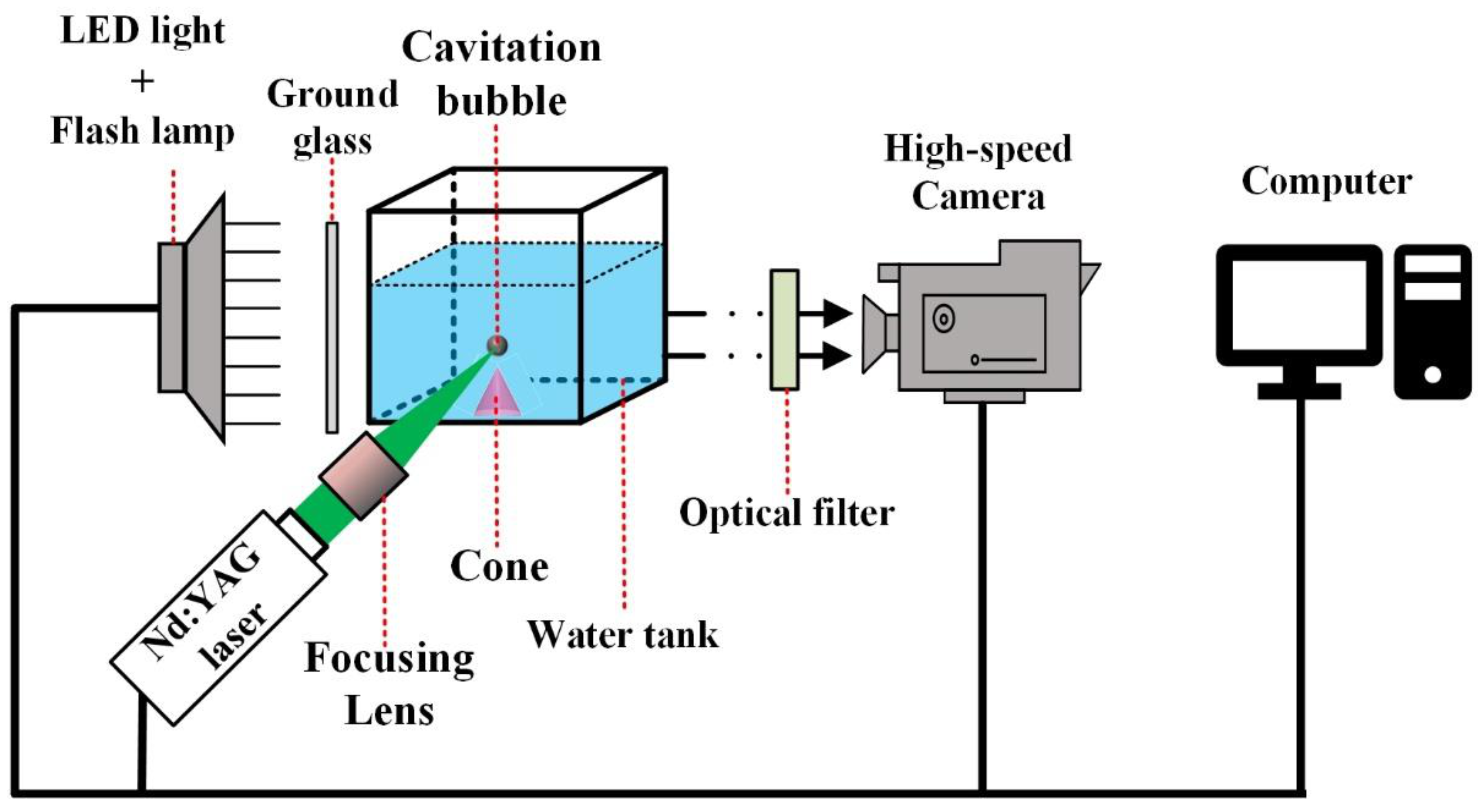

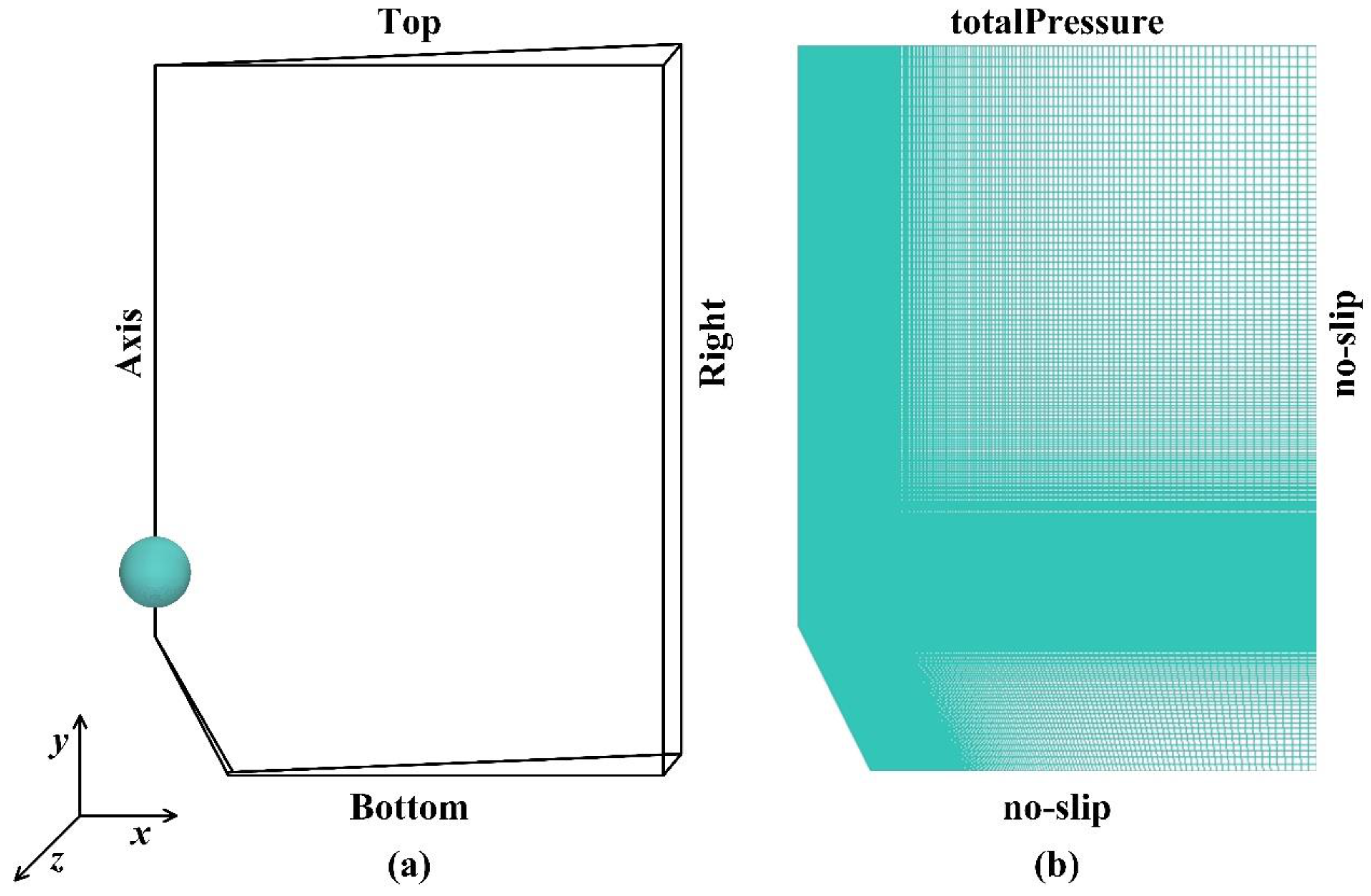

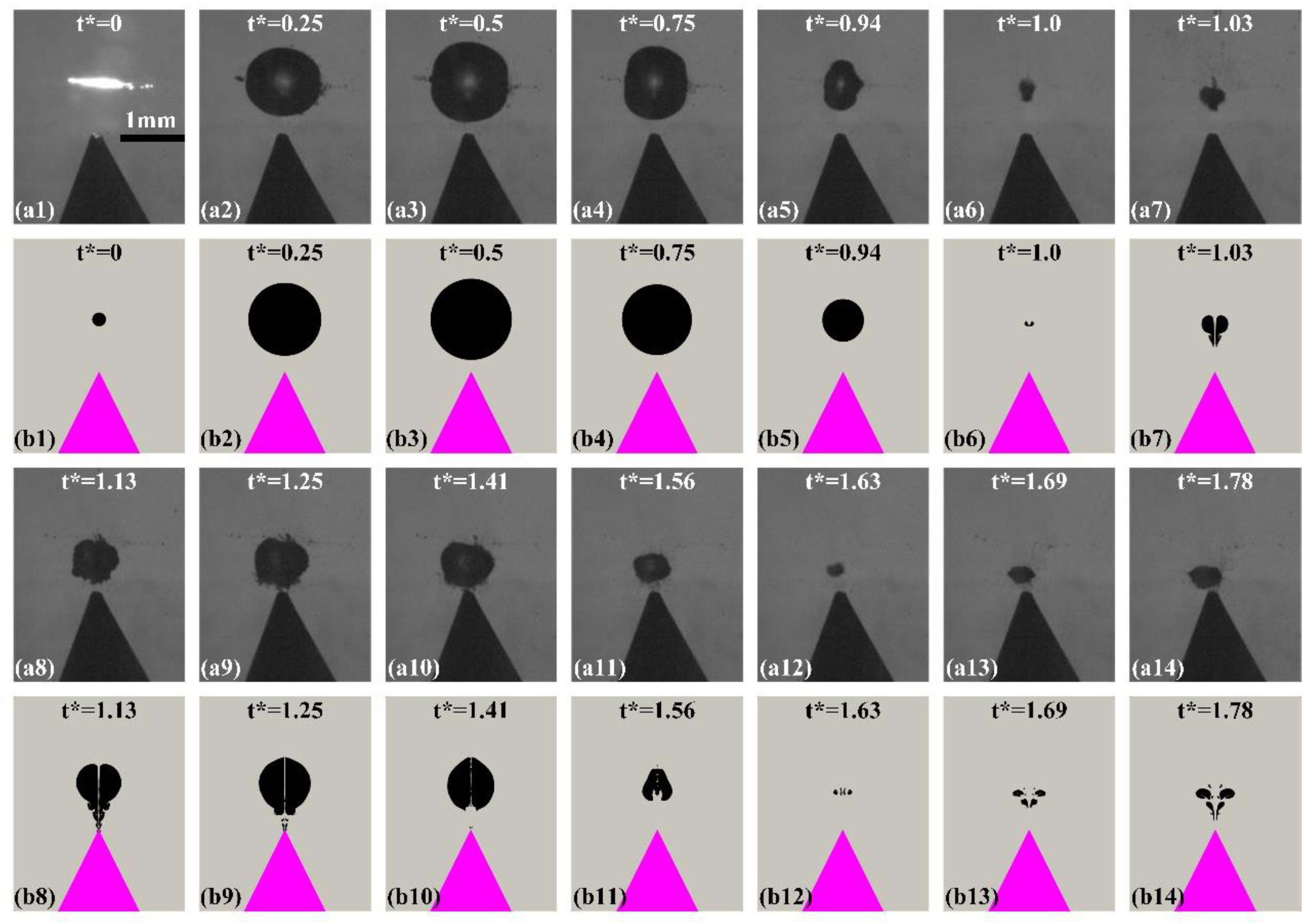



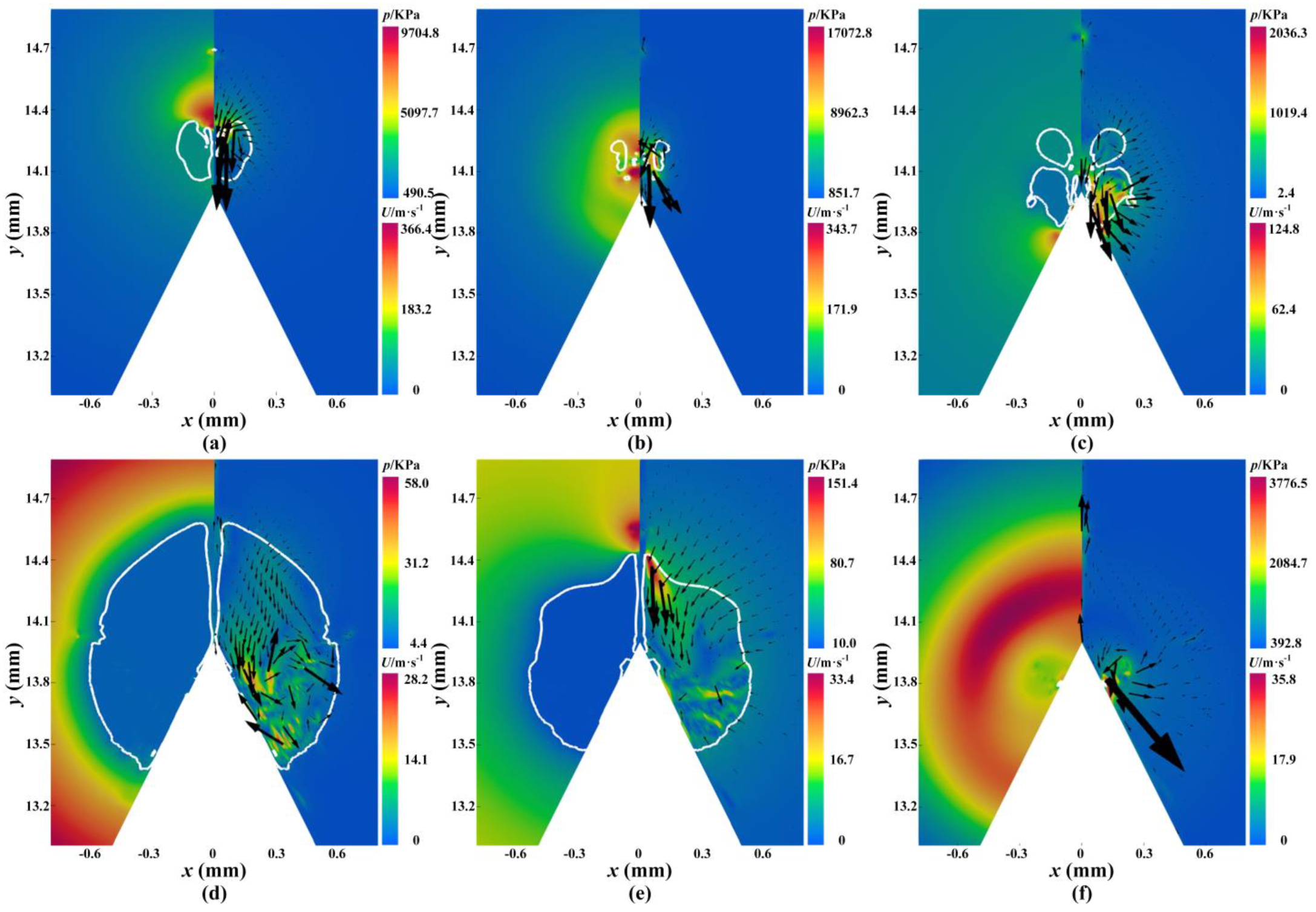
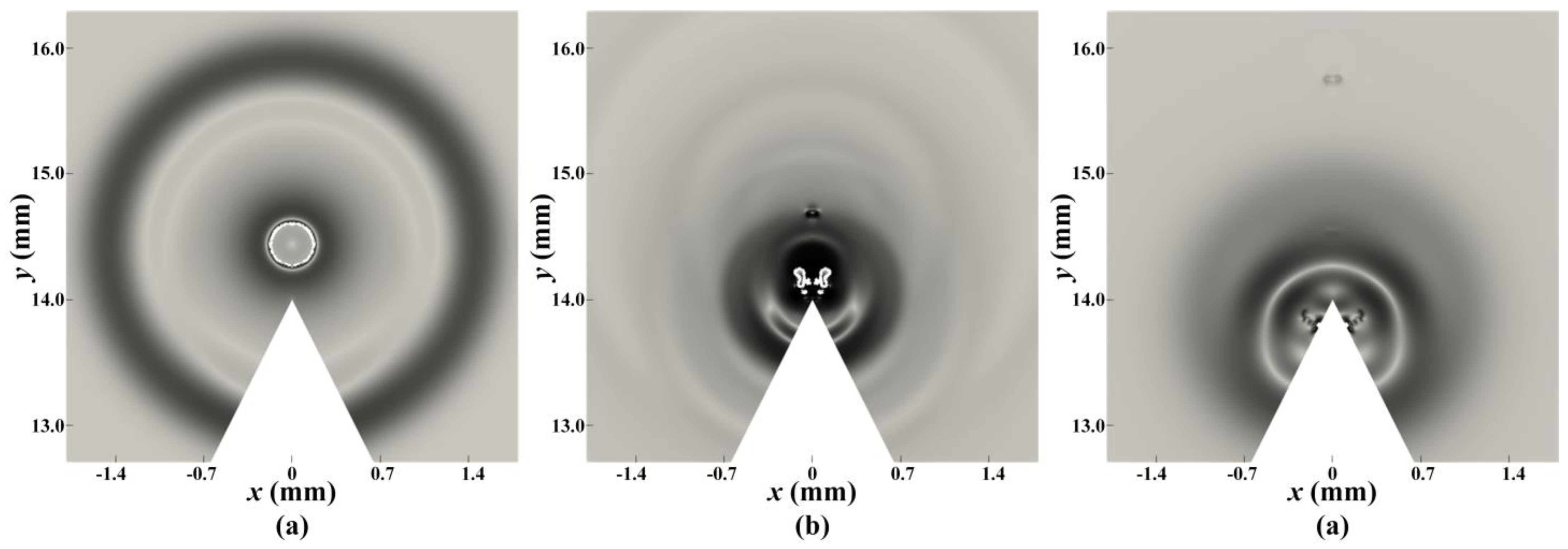
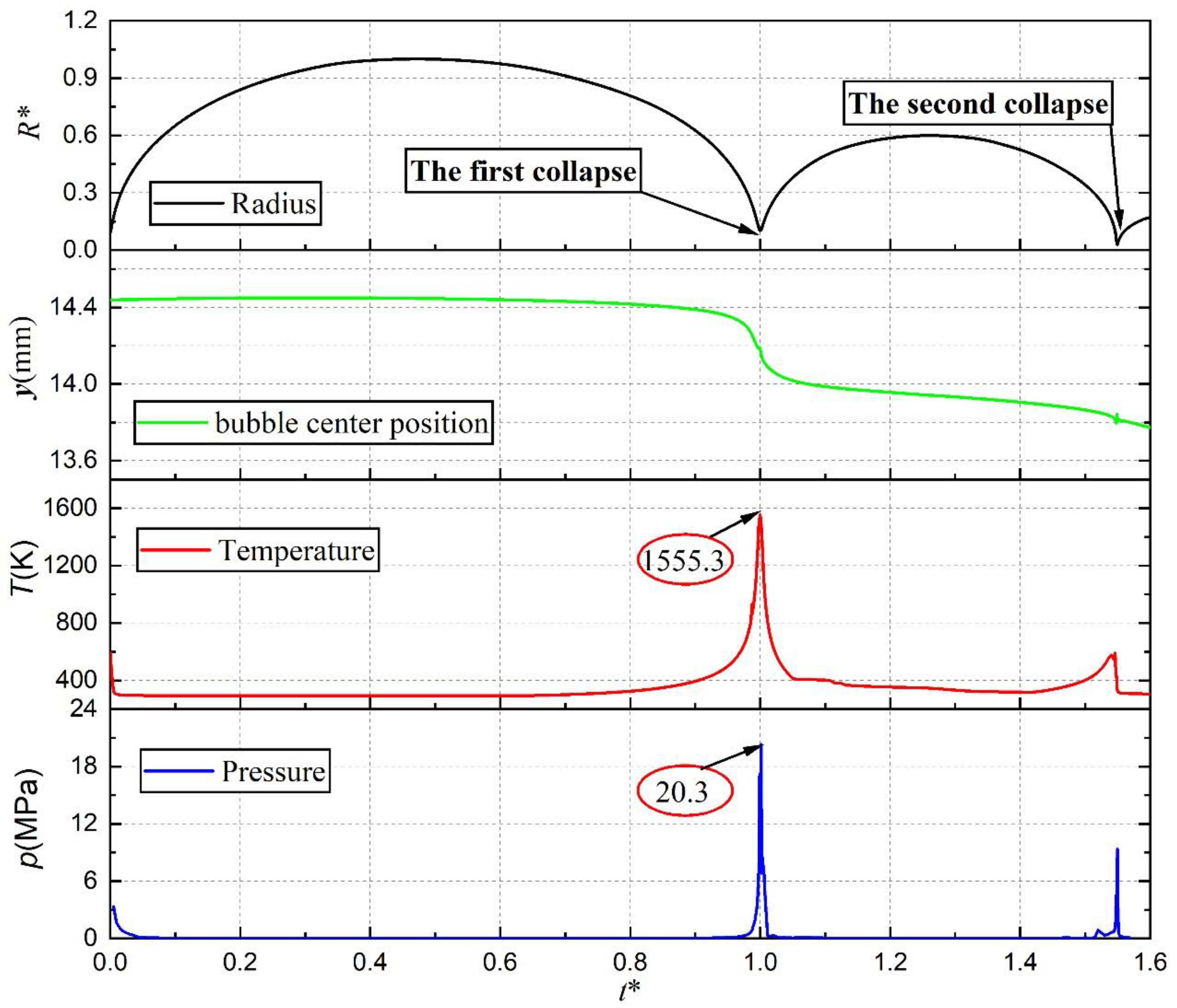

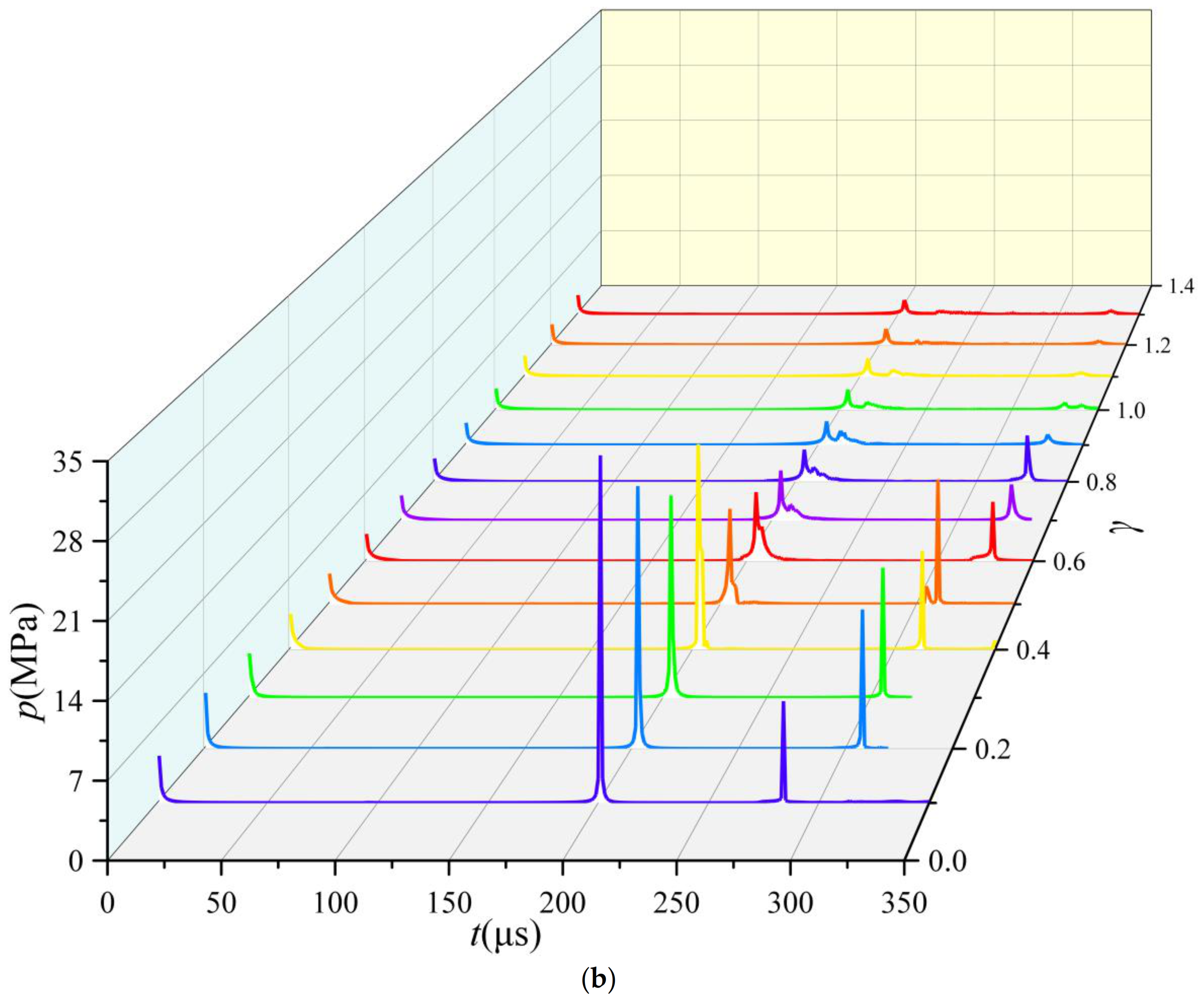
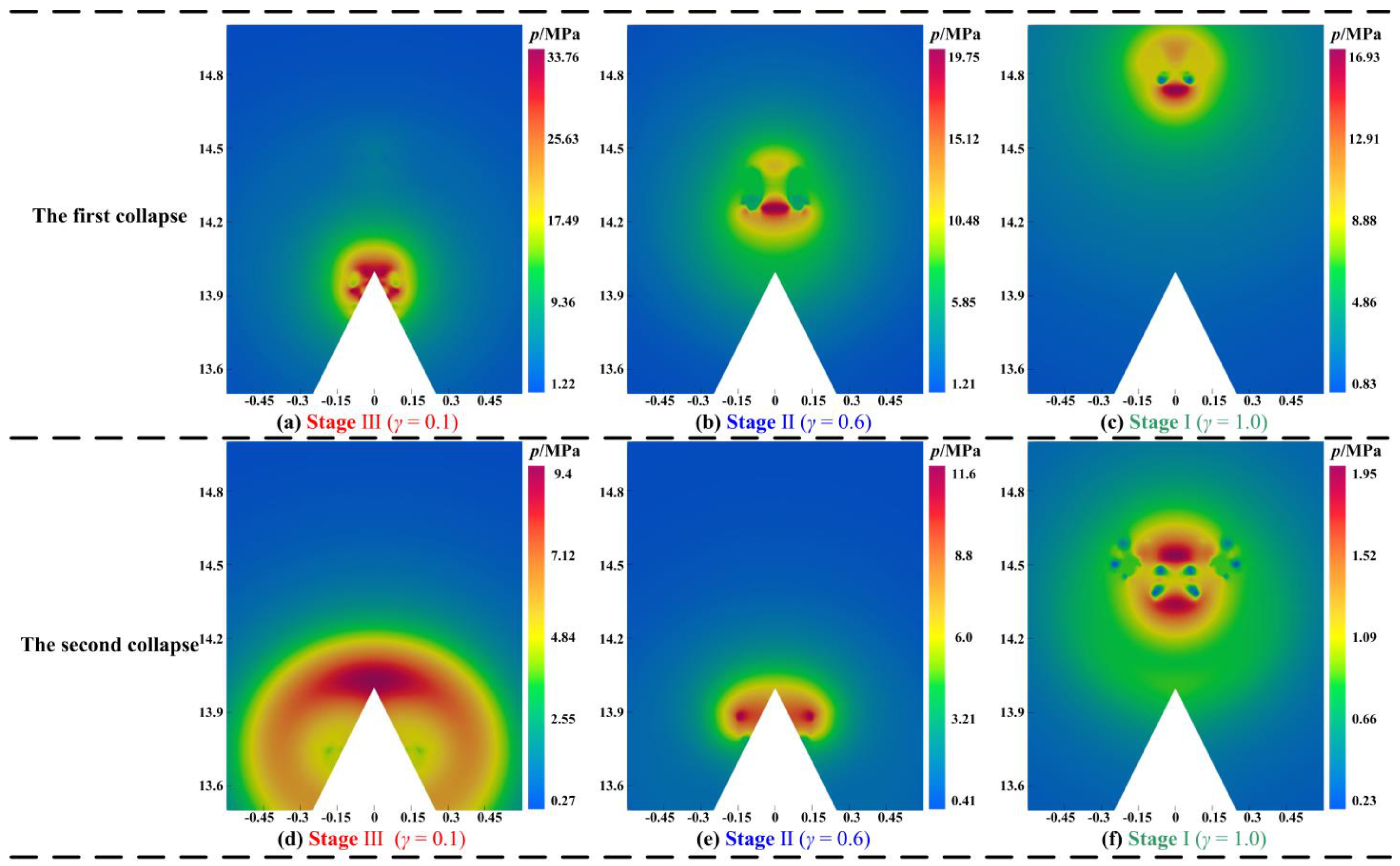


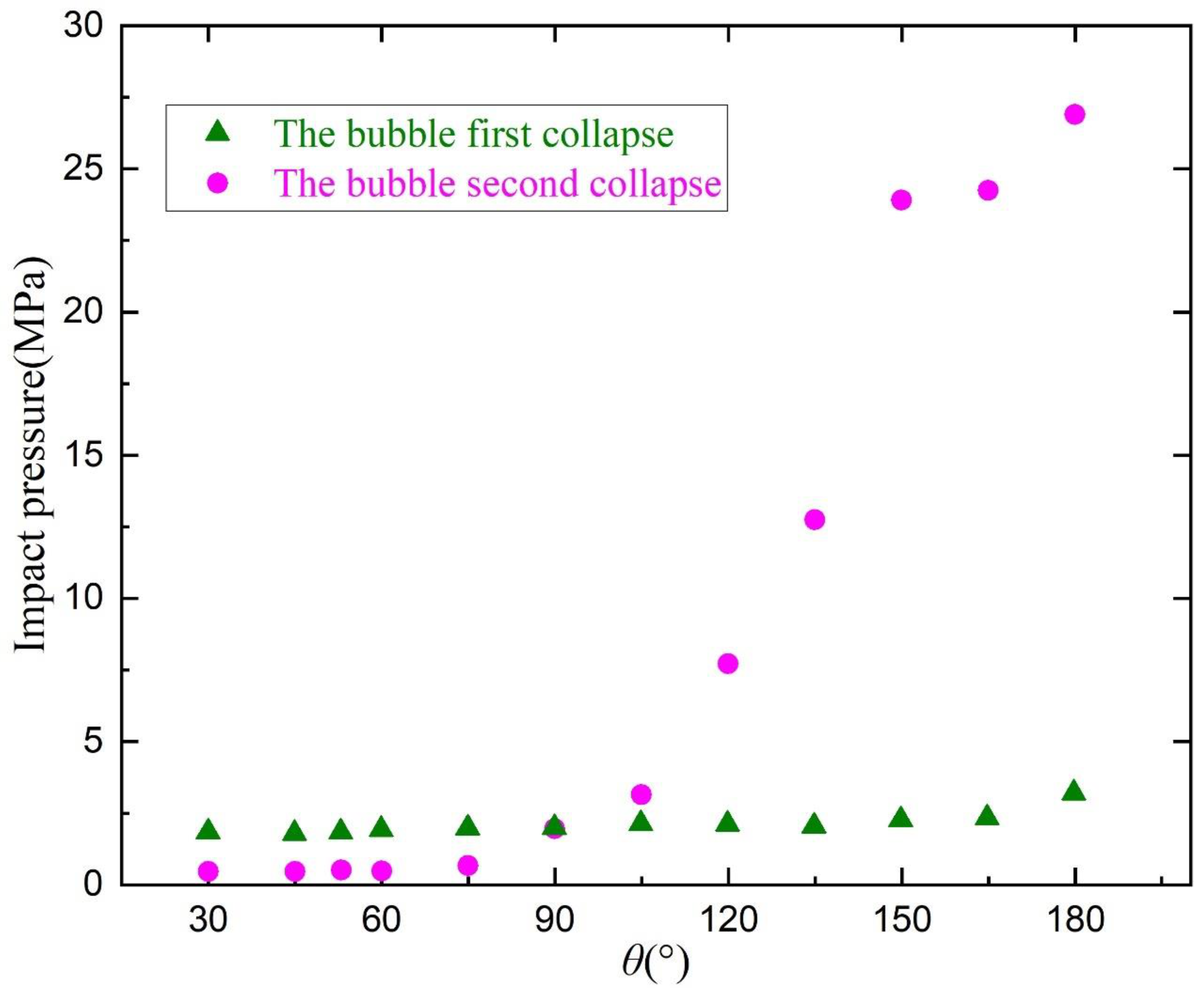
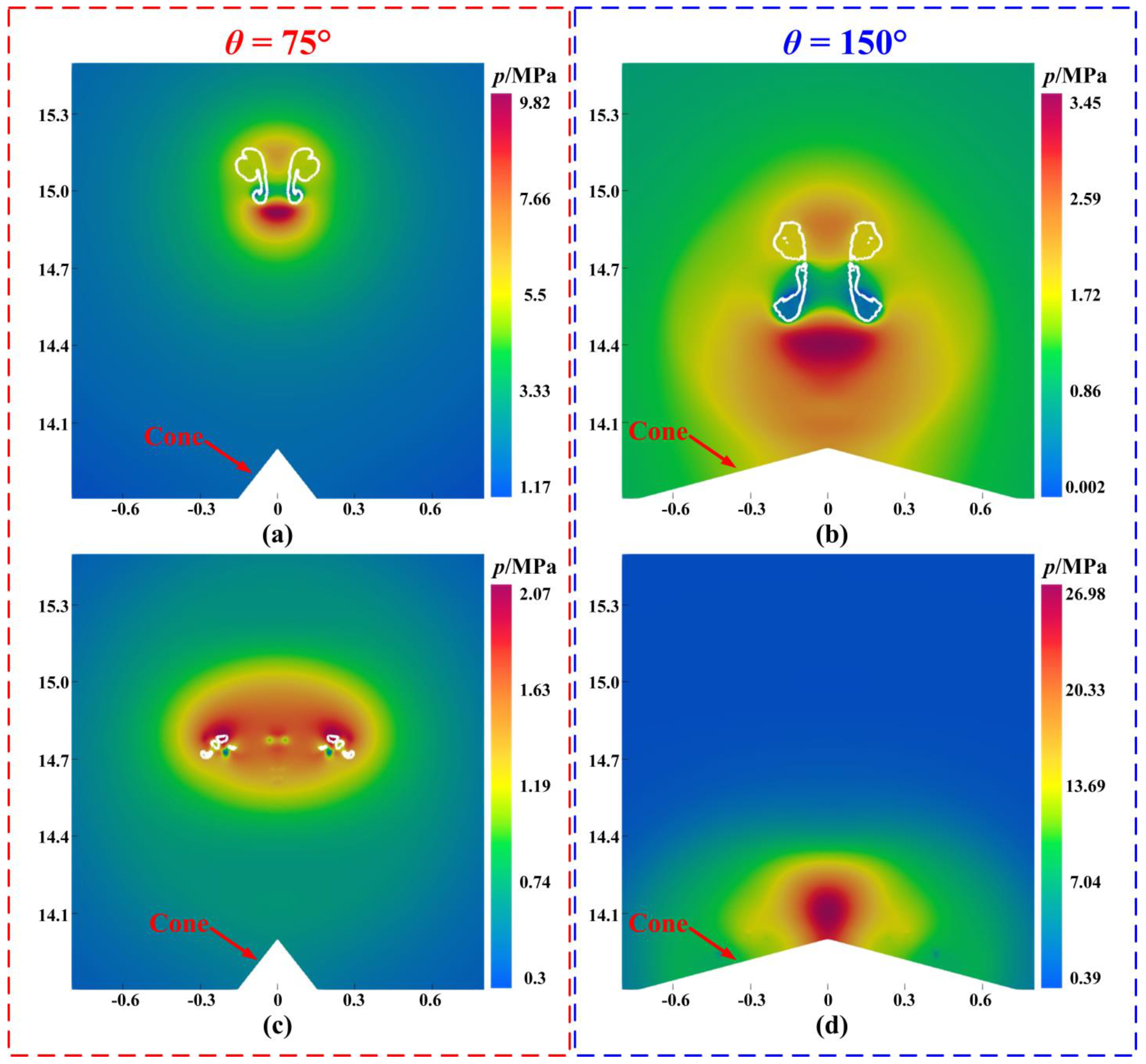
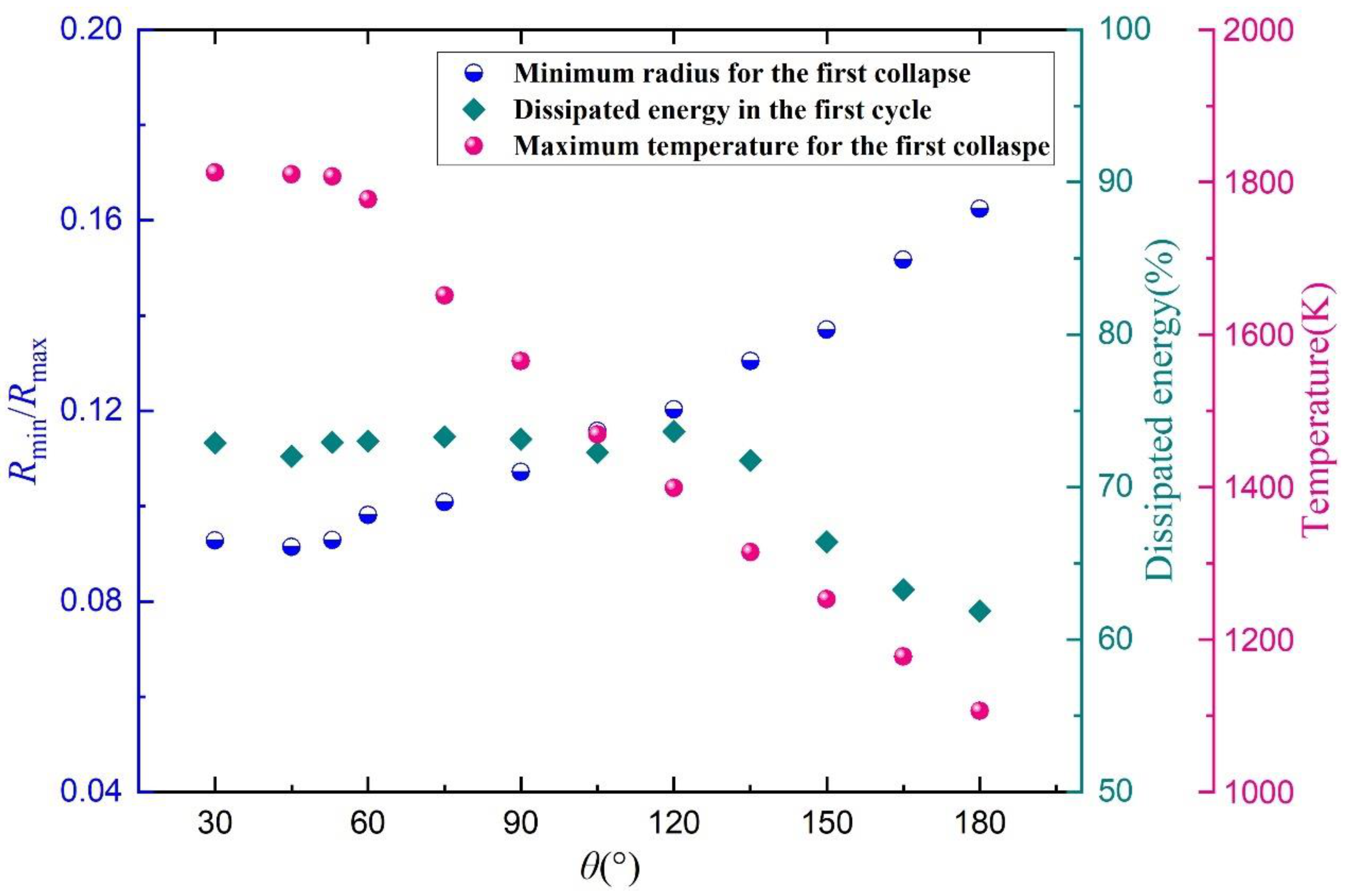
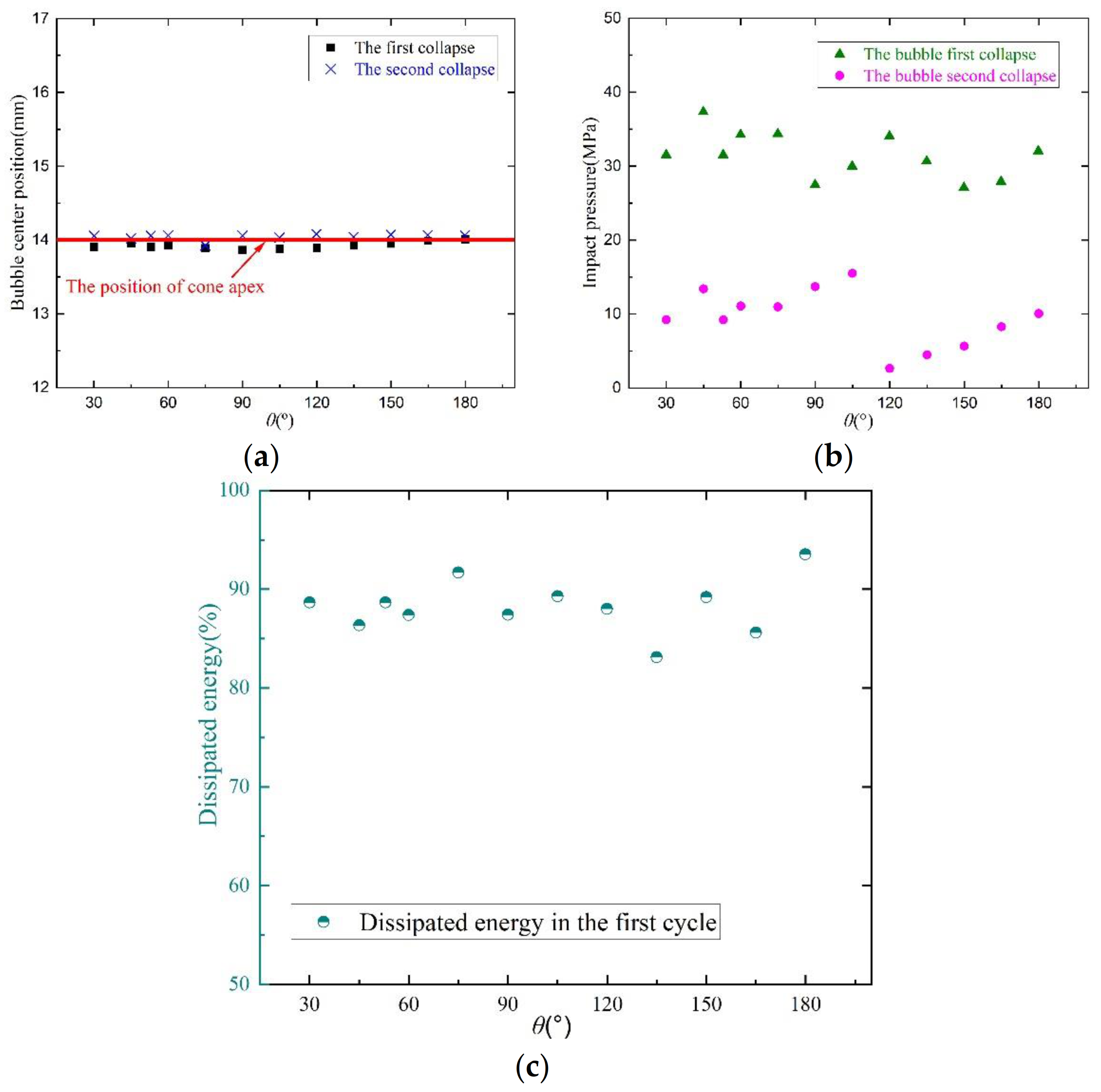
| ρ (kg/m3) | μ (Pa·s) | Cp (J/(kg·K)) | λ (W/(m·K)) | σ (N/m) | |
|---|---|---|---|---|---|
| Vapor | 0.0171 | 9.75 × 10−6 | 1862.6 | 0.02 | 0.07 |
| Water | 998.16 | 9.982 × 10−4 | 4180 | 0.677 |
Disclaimer/Publisher’s Note: The statements, opinions and data contained in all publications are solely those of the individual author(s) and contributor(s) and not of MDPI and/or the editor(s). MDPI and/or the editor(s) disclaim responsibility for any injury to people or property resulting from any ideas, methods, instructions or products referred to in the content. |
© 2023 by the authors. Licensee MDPI, Basel, Switzerland. This article is an open access article distributed under the terms and conditions of the Creative Commons Attribution (CC BY) license (https://creativecommons.org/licenses/by/4.0/).
Share and Cite
Yin, J.; Zhang, Y.; Gong, D.; Tian, L.; Du, X. Dynamics of a Laser-Induced Cavitation Bubble near a Cone: An Experimental and Numerical Study. Fluids 2023, 8, 220. https://doi.org/10.3390/fluids8080220
Yin J, Zhang Y, Gong D, Tian L, Du X. Dynamics of a Laser-Induced Cavitation Bubble near a Cone: An Experimental and Numerical Study. Fluids. 2023; 8(8):220. https://doi.org/10.3390/fluids8080220
Chicago/Turabian StyleYin, Jianyong, Yongxue Zhang, Dehong Gong, Lei Tian, and Xianrong Du. 2023. "Dynamics of a Laser-Induced Cavitation Bubble near a Cone: An Experimental and Numerical Study" Fluids 8, no. 8: 220. https://doi.org/10.3390/fluids8080220





